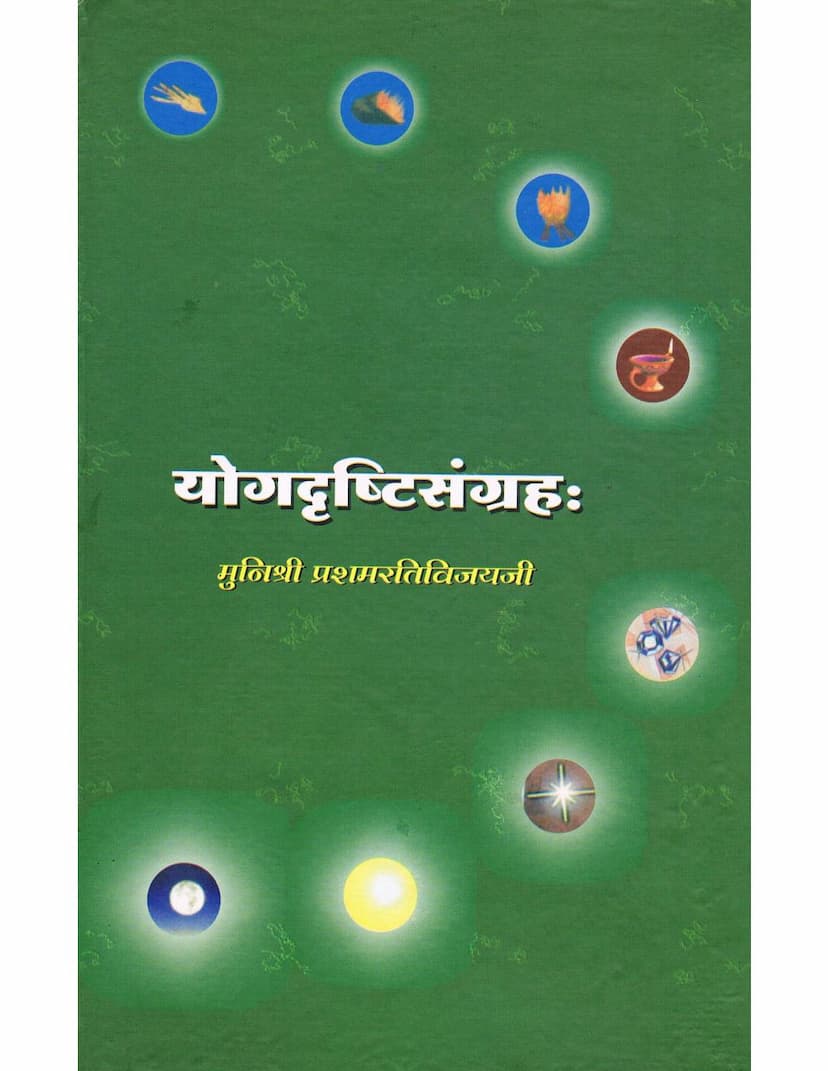Yogadrushti Sangraha
Added to library: September 2, 2025

Summary
The book "Yogadrushti Sangraha" by Muni Prashamrativijayji, published by Pravachan Prakashan Puna, is a compilation and synthesis of the teachings on the eight types of yogic vision, primarily drawing from the works of two prominent Jain scholars, Acharya Haribhadra Suri and Mahopadhyaya Yashovijayji. The catalog link provided is https://jainqq.org/explore/009512/1.
Here's a comprehensive summary of the text, based on the provided pages:
Overall Purpose and Structure:
The book aims to present a unified and comprehensive understanding of the eight yogic visions (drushtis) as taught in Jain scriptures. It achieves this by bringing together and comparing the insights from different foundational texts, particularly those of Acharya Haribhadra Suri (Yogadrishtisamucchaya) and Mahopadhyaya Yashovijayji (various Dwātrimśikās and Sajjhāyas). The text is structured to provide clarity on the subtle distinctions and progression through these yogic stages.
Key Contributors and Texts:
- Acharya Haribhadra Suri: His work, "Yogadrishtisamucchaya," forms a significant part of this compilation, offering the foundational understanding of the eight yogic visions.
- Mahopadhyaya Yashovijayji: His contributions include "Dwātrimśikās" (thirty-two-verse treatises) on various aspects of yoga and "Āth Drushtini Sajzhāy" (songs or devotional verses on the eight visions). The book also references a commentary by Acharya Gyanvimal Suri on the "Āth Drushtini Sajzhāy."
Core Concepts and Themes:
-
The Eight Yogic Visions (Drushtis): The central theme is the exploration and elucidation of eight distinct yogic perspectives or states of consciousness. These are identified by names such as Mitra (friendly), Tara (star-like), Bala (strong), Diptā (radiant), Sthira (firm), Kāntā (beloved), Prabhā (light), and Parā (supreme). Each vision represents a stage of spiritual development and understanding.
-
Integration of Different Scholarly Perspectives: The author, Muni Prashamrativijayji, has undertaken the task of harmonizing the teachings of Haribhadra Suri and Yashovijayji. This compilation allows for a comparative study, highlighting the nuances and completeness of their respective analyses of the yogic states.
-
The Nature of Yoga: The text delves into the definition and categories of yoga. It differentiates between:
- Ichchāyoga (Willful Yoga): Yoga undertaken with a desire, potentially flawed or incomplete due to misinterpretations or imperfect practice.
- Shāstrayoga (Scriptural Yoga): Yoga based on following the scriptures, understanding their principles, and adhering to prescribed practices, even with some remaining imperfections.
- Sāmarthyayoga (Powerful Yoga): This is the highest form, characterized by profound insight, mastery, and the ability to transcend scriptural limitations through direct experience and realization. It is described as going beyond the literal interpretation of scriptures, leading to the ultimate goal.
-
Progression and Stages of Yoga: The eight visions are presented as progressive stages in the development of yogic understanding and practice. The text details the characteristics, benefits, and potential pitfalls at each stage.
-
Emphasis on Right Understanding (Samyak Darshan): A significant portion of the text seems dedicated to clarifying the foundational importance of right faith or understanding (Samyak Darshan) in the context of yoga. The author critiques misinterpretations of yogic principles that might lead to prioritizing yogic techniques over ethical conduct or right belief.
-
Critique of Misconceptions: The text addresses contemporary misinterpretations of yoga, such as:
- Undermining the importance of ethical conduct (Āchāradharma) in favor of yogic experiences.
- Using yogic concepts to promote syncretism or disregard for specific doctrinal differences.
- Misattributing certain interpretations or characteristics of Haribhadra Suri's teachings to his broader vision, when they might represent an intermediate stage of development.
-
Detailed Exploration of Each Vision: The book elaborates on each of the eight visions, often using similes and metaphors to explain their nature. For instance, Mitra (the first vision) is described as having a 'gentle' or 'weak' understanding, akin to the flame of a grass-fire, needing to develop further. Later visions are compared to more potent sources of light like stars, the sun, and the moon, signifying increasing clarity and power.
-
Structure of the Commentary: The text often follows a pattern of introducing a vision, explaining its characteristics (like the level of understanding, ethical practices involved, and the yogic 'limbs' utilized), and sometimes critiquing or clarifying common misconceptions related to that stage.
Specific Insights Highlighted:
- First Vision (Mitra): Characterized by a mild understanding, association with Yamas (ethical restraints), freedom from fatigue in devotion, and absence of malice towards others. It involves accepting what is suitable and performing duties without excessive attachment or aversion.
- Subsequent Visions (Tara, Bala, Diptā, Sthira, Kāntā, Prabhā, Parā): These progress in intensity, clarity, power, and detachment. Sthira involves firm resolve and absence of deviation. Kāntā leads to being beloved and respected. Prabhā brings deep meditation and clarity. Parā represents the highest state of realization.
- Yoga Limbs (Yama, Niyama, etc.): The text likely integrates the discussion of the eight limbs of yoga (Yama, Niyama, Āsana, Prāṇāyāma, Pratyāhāra, Dhāraṇā, Dhyāna, Samādhi) within the context of these eight visions, showing how they are cultivated at different stages.
- Importance of Correct Interpretation: The author emphasizes the need for accurate understanding of scriptural references, cautioning against misinterpretations that might distort the original teachings.
Overall Significance:
"Yogadrushti Sangraha" serves as a valuable resource for understanding the intricate path of yoga within the Jain tradition. By synthesizing the teachings of eminent scholars, it provides a structured and accessible framework for spiritual aspirants to comprehend and progress through the various stages of yogic development. The emphasis on right understanding and the critique of misconceptions aim to guide practitioners toward authentic spiritual growth.